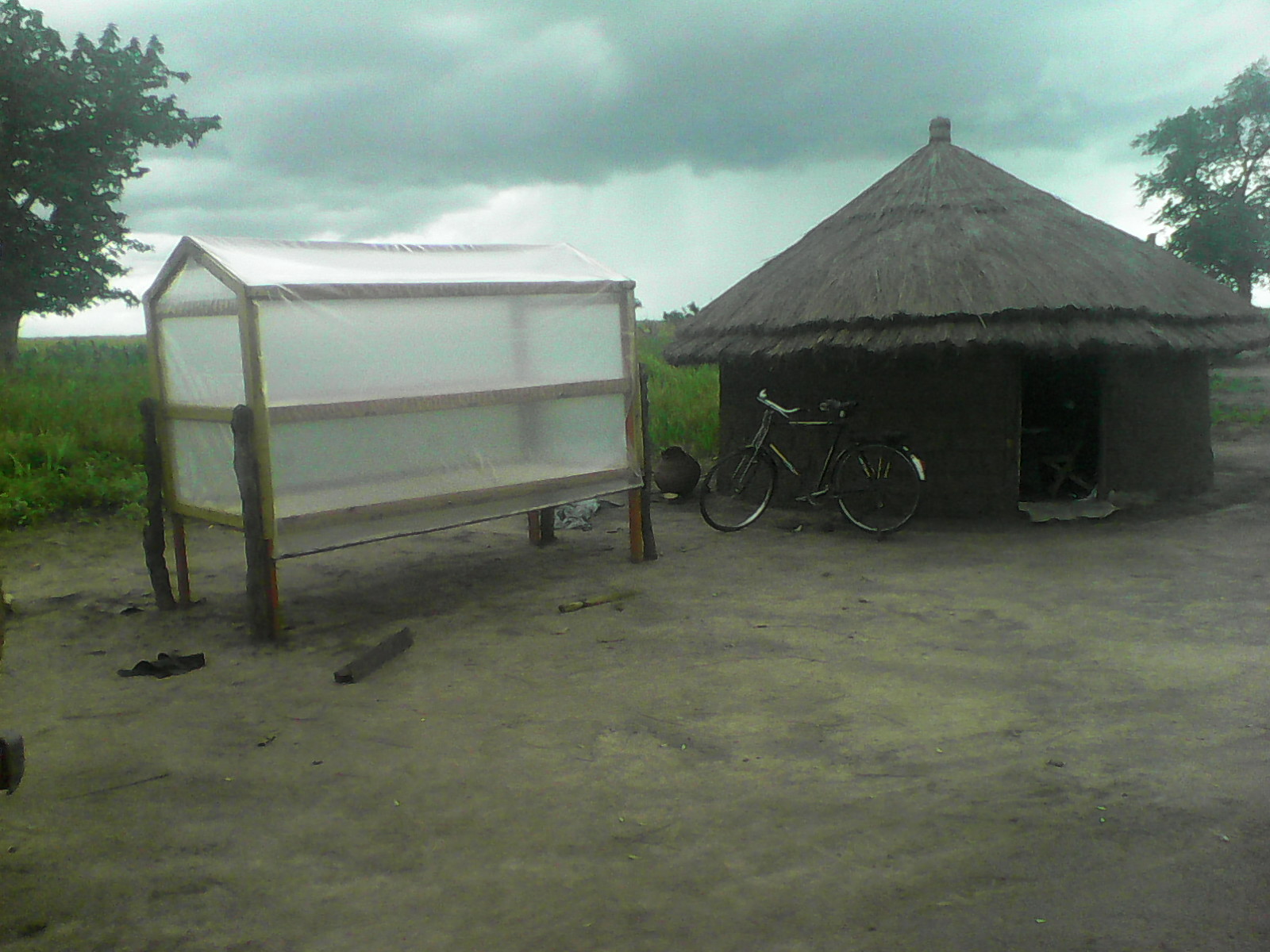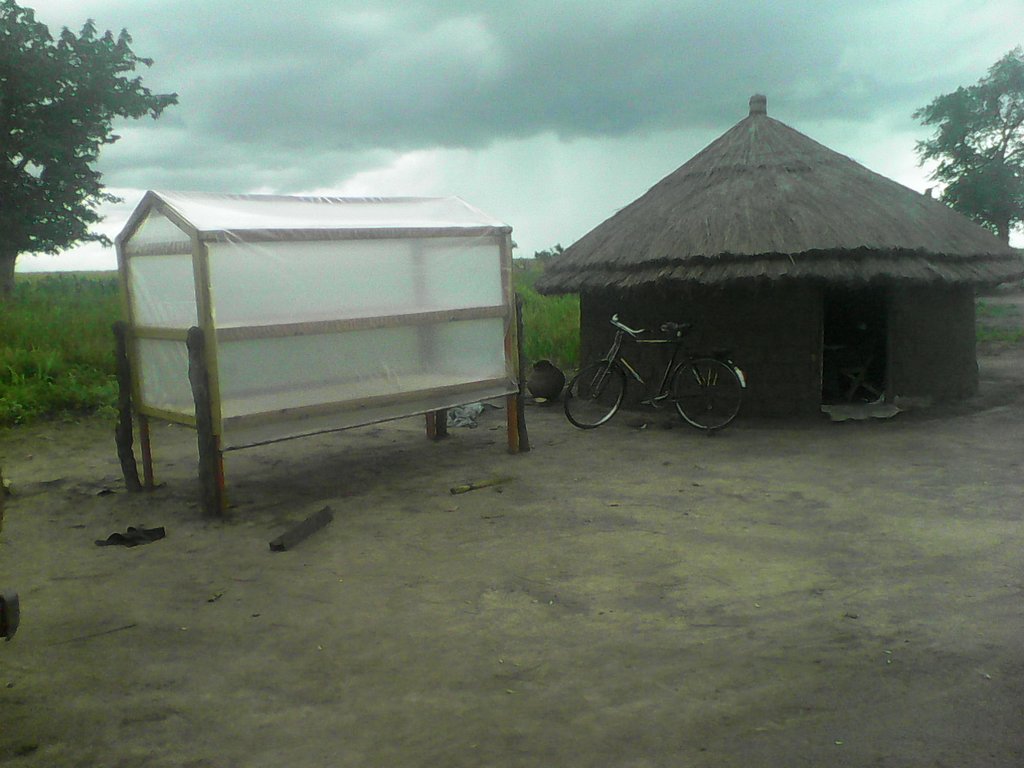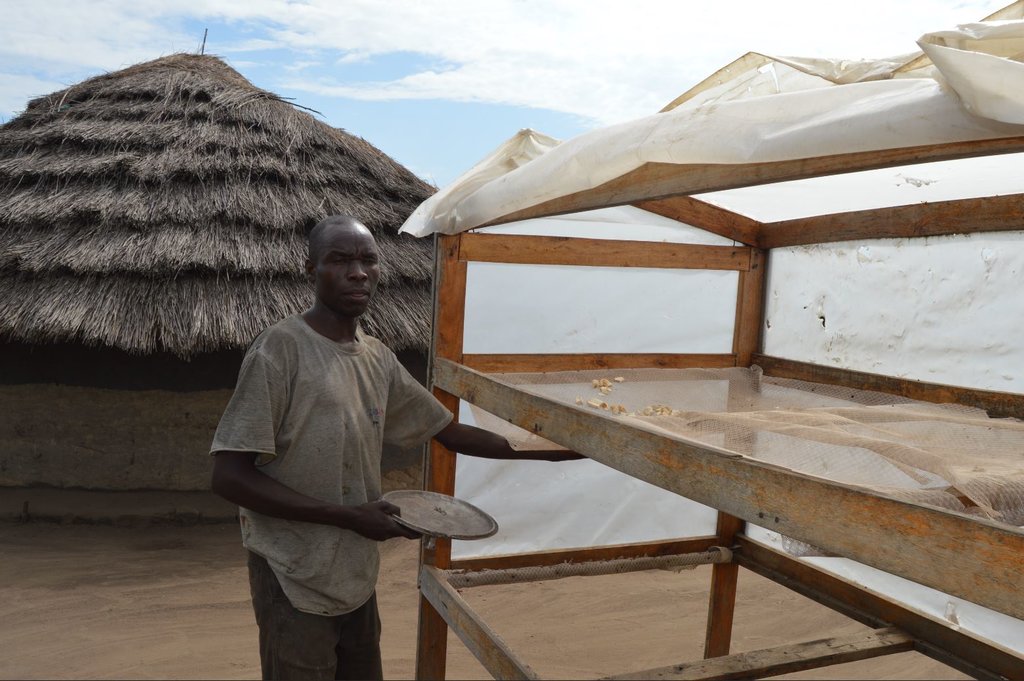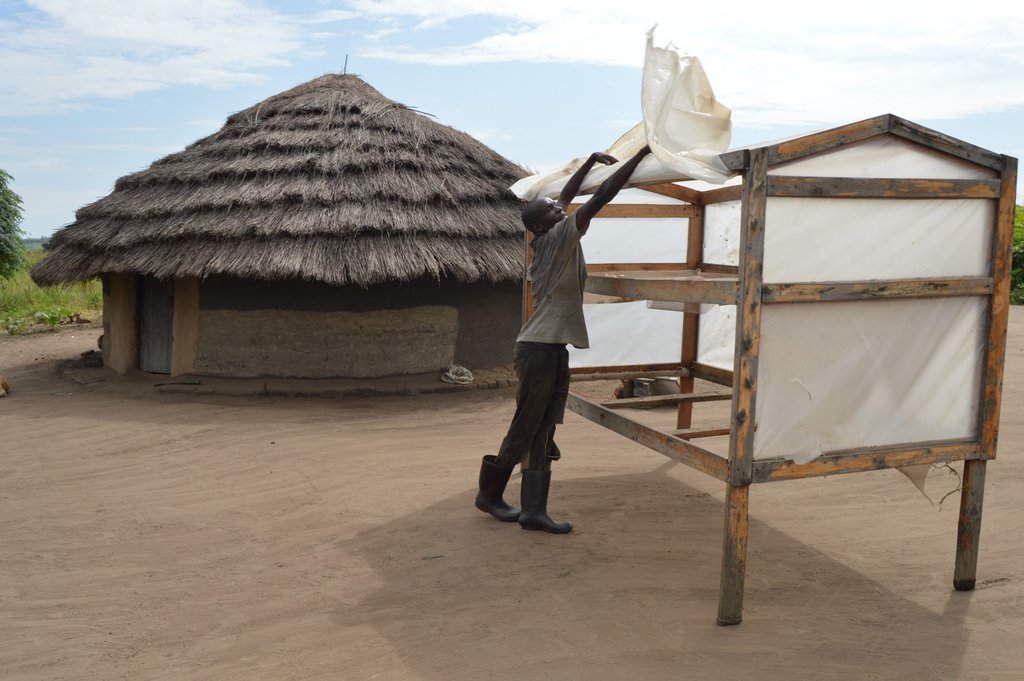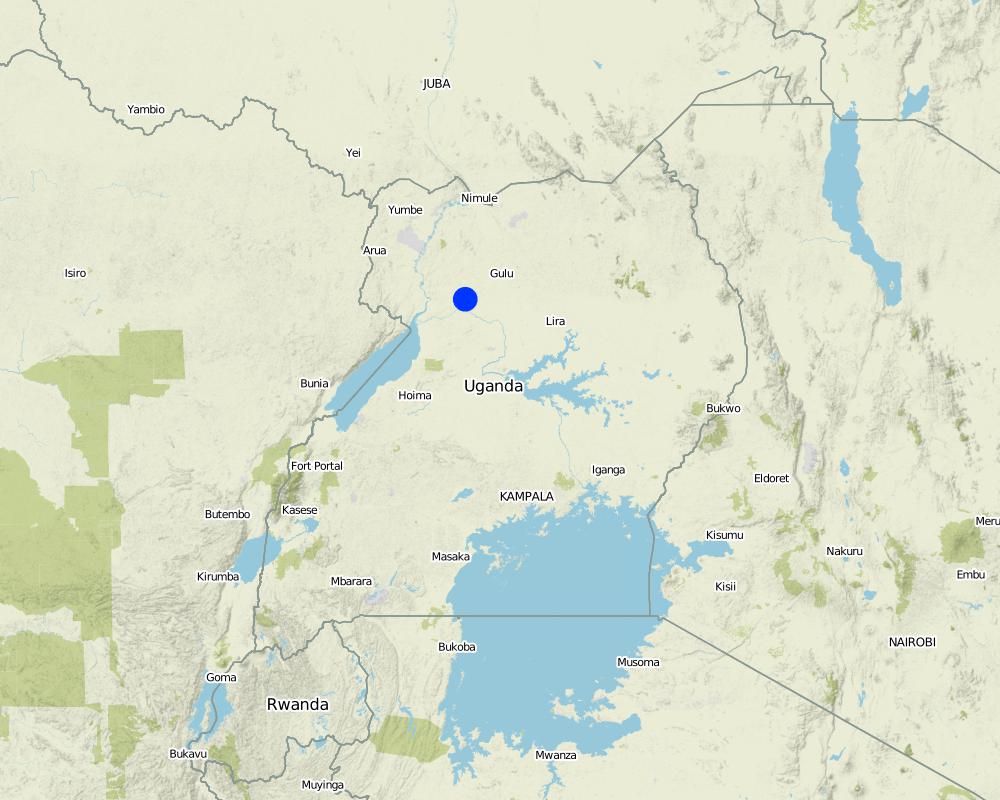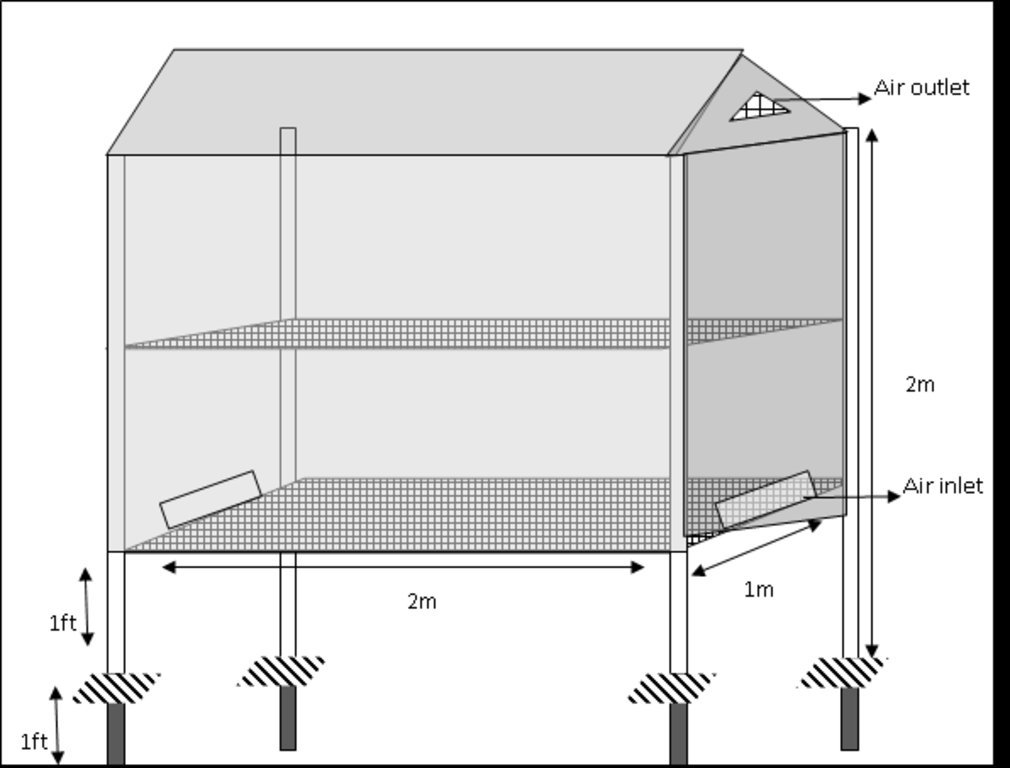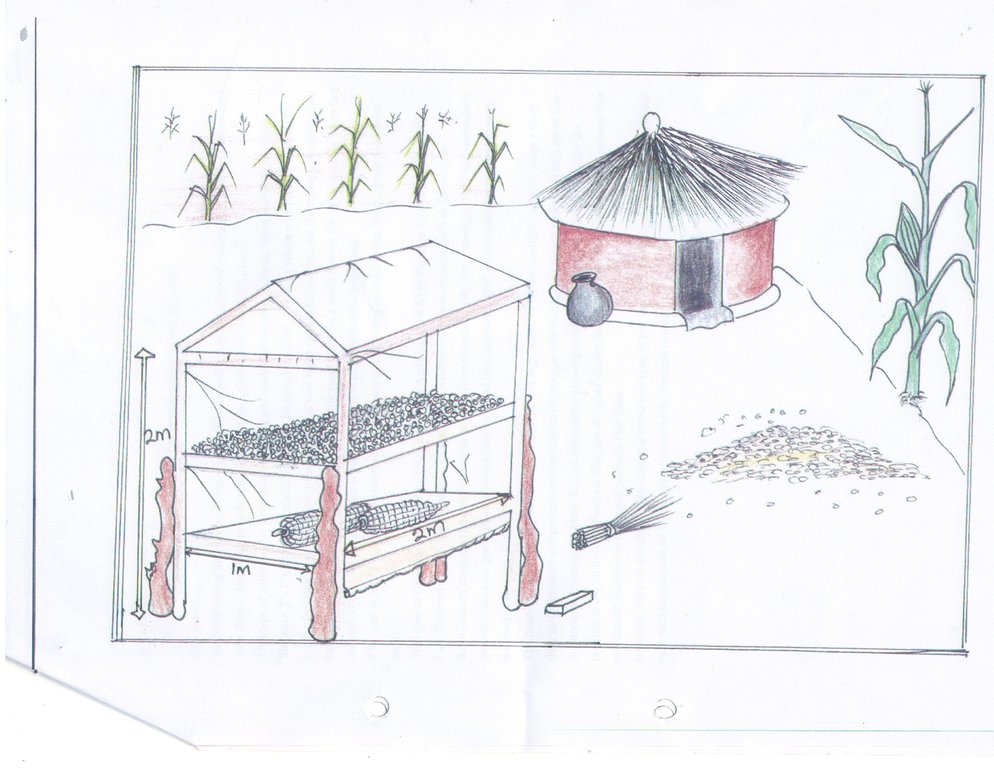Low-cost solar drier for preserving crop produce [乌干达]
- 创建:
- 更新:
- 编制者: Sunday Balla Amale
- 编辑者: JOY TUKAHIRWA, Kamugisha Rick Nelson, Bernard Fungo, betty adoch
- 审查者: John Stephen Tenywa, Nicole Harari, Alexandra Gavilano
twoyo cam ki cheny
technologies_3330 - 乌干达
查看章节
全部展开 全部收起1. 一般信息
1.2 参与该技术评估和文件编制的资源人员和机构的联系方式
关键资源人
SLM专业人员:
Odong Kilama
Local Farmer
乌干达
有助于对技术进行记录/评估的项目名称(如相关)
Scaling-up SLM practices by smallholder farmers (IFAD)有助于对技术进行记录/评估的机构名称(如相关)
Uganda Landcare Network (ULN) - 乌干达1.3 关于使用通过WOCAT记录的数据的条件
编制者和关键资源人员接受有关使用通过WOCAT记录数据的条件。:
是
1.4 所述技术的可持续性声明
这里所描述的技术在土地退化方面是否存在问题,导致无法被认为是一种可持续的土地管理技术?:
否
2. SLM技术的说明
2.1 技术简介
技术定义:
A portable wooden frame solar drier with polythene cover used for drying low moisture content crop produce such as chili and maize. The crop is placed inside the drier and takes 2-3 days to dry depending on the humidity and moisture content at harvest.
2.2 技术的详细说明
说明:
Postharvest crop losses constitute a major concern among farming communities in northern Uganda. This is primarily due to suboptimal drying facilities used by farmers, despite the availability of all year round natural solar radiation. It was in light of this challenge that the Uganda Wildlife Authority (UWA) introduced and promoted a low-cost handy solar drier among the rural farming communities in and around the Murchison Falls National Park. The purpose was to reduce human wildlife conflict incidences such as poaching or destruction of crops and properties by stray animals from the game park. The technology bears potential for out scaling to other non-targeted communities as well.
The drier consists of a wooden frame made from locally available wood material (preferably timber of 2" x 3"), measuring about 1 m wide by 2 m long and 2 m high. The floor where crop produce is placed is made of mesh of materials such as wire mesh or papyrus mat. The entire frame is surrounded by a 0.2 mm thick transparent UV stabilized plastic sheet, leaving a small portion for air inlet on the lower bed and exit vent at the top. The drier is placed in an open air place within the homestead.
The drier is most suited for drying low moisture content crop produce such as chili, maize, beans and green vegetables.
The drier is able to dry crop produce during periods of high humidity or low sunlight intensity, cover a short time to dry produce and prevents contamination of produce with bacterial or fungal spores that may occur due to improper drying procedures. It is not affected by blowing wind or rainfall; thus a farmer can leave the produce to dry on its own. Produce dried are of higher quality than when dried in open sun. The drier also reduces loss of valuable vitamins in fruits and prevents fruit burning. However, the cost associated with buying a brand new type of this drier made from modern materials is high.
2.3 技术照片
2.5 已应用该技术的、本评估所涵盖的国家/地区/地点
国家:
乌干达
区域/州/省:
Nwoya district
有关地点的进一步说明:
Anaka sub-county, Agung village
具体说明该技术的分布:
- 适用于特定场所/集中在较小区域
注释:
Farmer located in Agung Village, Laliya sub village
applied at specific points/ concentrated on a small area
Map
×2.6 实施日期
如果不知道确切的年份,请说明大概的日期:
- 不到10年前(最近)
2.7 技术介绍
详细说明该技术是如何引入的:
- 通过项目/外部干预
注释(项目类型等):
Project by Uganda Wildlife Authority for the neighboring communities surrounding the national park as a measure to result human wildlife conflicts through encouraging production of crops not destroyed by wildlife.
3. SLM技术的分类
3.1 该技术的主要目的
- 改良生产
- 创造有益的经济影响
- 创造有益的社会影响
3.2 应用该技术的当前土地利用类型

农田
- 一年一作
年作 - 具体指明作物:
- 谷物类 - 玉米
- 豆科牧草和豆类 - 豆子
- chili, green vegetables, fruits
每年的生长季节数:
- 2
具体说明:
1st rain mid march to june; 2nd rain mid july to november

定居点、基础设施
- 定居点、建筑物
注释:
The technology is applied within the home stead
3.4 供水
该技术所应用土地的供水:
- 雨养
3.5 该技术所属的SLM组
- 收割后的措施
3.6 包含该技术的可持续土地管理措施

其它措施
注释:
post harvest handling of farm produce
3.7 该技术强调的主要土地退化类型

其它
注释:
helps to preserve produce in sustainable way, thus indirectly addressing land degradation
3.8 防止、减少或恢复土地退化
具体数量名该技术与土地退化有关的目标:
- 不适用
4. 技术规范、实施活动、投入和成本
4.1 该技术的技术图纸
技术规范(与技术图纸相关):
Rectangular solar dryer of the following dimensions: about 1m wide, 2m long, 2m high. The stand enters 1 foot into the ground to ensure firmness. The tray for putting the produce is about 1 foot above the ground surface and ensures free circulation of air underneath, and also prevents domestic animals from feeding on the produce.
作者:
amale balla sunday
日期:
05/04/2018
4.2 有关投入和成本计算的一般信息
具体说明成本和投入是如何计算的:
- 每个技术单元
指定单位:
Solar dryer
其它/国家货币(具体说明):
Uganda Shillings
如相关,注明美元与当地货币的汇率(例如1美元=79.9巴西雷亚尔):1美元=:
3650.0
注明雇用劳工的每日平均工资成本:
5000
4.3 技术建立活动
| 活动 | 时间(季度) | |
|---|---|---|
| 1. | Acquiring materials for constructing the drier | any period of the year |
| 2. | Constructing the drier | anytime of the year |
4.4 技术建立所需要的费用和投入
| 对投入进行具体说明 | 单位 | 数量 | 单位成本 | 每项投入的总成本 | 土地使用者承担的成本% | |
|---|---|---|---|---|---|---|
| 劳动力 | carpenter | personnel | 2.0 | 15000.0 | 30000.0 | |
| 施工材料 | Timber 3"X2" | pieces | 10.0 | 9000.0 | 90000.0 | |
| 施工材料 | Stabilised UV sheet | square meter | 12.0 | 15000.0 | 180000.0 | |
| 施工材料 | Iron nails assorted | kg | 2.0 | 6000.0 | 12000.0 | |
| 技术建立所需总成本 | 312000.0 | |||||
| 技术建立总成本,美元 | 85.48 | |||||
如果您无法分解上表中的成本,请估算建立该技术所需要的总成本。:
200000.0
如果土地使用者负担的费用少于100%,请注明由谁负担其余费用:
Uganda Wildlife Authority
4.5 维护/经常性活动
| 活动 | 时间/频率 | |
|---|---|---|
| 1. | Repairs | anytime of the year |
4.6 维护/经常性活动所需要的费用和投入(每年)
| 对投入进行具体说明 | 单位 | 数量 | 单位成本 | 每项投入的总成本 | 土地使用者承担的成本% | |
|---|---|---|---|---|---|---|
| 劳动力 | personnel | persons | 2.0 | 10000.0 | 20000.0 | 100.0 |
| 施工材料 | UV stabilized polythene sheet | square meters | 5.0 | 15000.0 | 75000.0 | 100.0 |
| 施工材料 | Iron nails (assorted) | kg | 1.0 | 6000.0 | 6000.0 | 100.0 |
| 技术维护所需总成本 | 101000.0 | |||||
| 技术维护总成本,美元 | 27.67 | |||||
注释:
The solar drier is maintained whenever the polythene sheet tears off; usually after three years as recommended by Uganda Wildlife Authority
4.7 影响成本的最重要因素
描述影响成本的最决定性因素:
Material costs for constructing the drier. These include cost of timber, stabilized UV polythene sheet and iron nails.
5. 自然和人文环境
5.1 气候
年降雨量
- < 250毫米
- 251-500毫米
- 501-750毫米
- 751-1,000毫米
- 1,001-1,500毫米
- 1,501-2,000毫米
- 2,001-3,000毫米
- 3,001-4,000毫米
- > 4,000毫米
有关降雨的规范/注释:
convectional rainfall, two rainy seasons
农业气候带
- 半湿润
5.2 地形
平均坡度:
- 水平(0-2%)
- 缓降(3-5%)
- 平缓(6-10%)
- 滚坡(11-15%)
- 崎岖(16-30%)
- 陡峭(31-60%)
- 非常陡峭(>60%)
地形:
- 高原/平原
- 山脊
- 山坡
- 山地斜坡
- 麓坡
- 谷底
垂直分布带:
- 0-100 m a.s.l.
- 101-500 m a.s.l.
- 501-1,000 m a.s.l.
- 1,001-1,500 m a.s.l.
- 1,501-2,000 m a.s.l.
- 2,001-2,500 m a.s.l.
- 2,501-3,000 m a.s.l.
- 3,001-4,000 m a.s.l.
- > 4,000 m a.s.l.
说明该技术是否专门应用于:
- 不相关
5.3 土壤
平均土层深度:
- 非常浅(0-20厘米)
- 浅(21-50厘米)
- 中等深度(51-80厘米)
- 深(81-120厘米)
- 非常深(> 120厘米)
土壤质地(表土):
- 中粒(壤土、粉土)
土壤质地(地表以下> 20厘米):
- 粗粒/轻(砂质)
表土有机质:
- 中(1-3%)
5.4 水资源可用性和质量
地下水位表:
5-50米
地表水的可用性:
中等
水质(未处理):
不良饮用水(需要处理)
水的盐度有问题吗?:
否
该区域正在发生洪水吗?:
否
5.5 生物多样性
物种多样性:
- 中等
栖息地多样性:
- 低
5.6 应用该技术的土地使用者的特征
定栖或游牧:
- 定栖的
生产系统的市场定位:
- 混合(生计/商业)
非农收入:
- 低于全部收入的10%
相对财富水平:
- 贫瘠
个人或集体:
- 个人/家庭
机械化水平:
- 手工作业
性别:
- 女人
- 男人
土地使用者的年龄:
- 青年人
- 中年人
5.7 应用该技术的土地使用者使用的平均土地面积
- < 0.5 公顷
- 0.5-1 公顷
- 1-2 公顷
- 2-5公顷
- 5-15公顷
- 15-50公顷
- 50-100公顷
- 100-500公顷
- 500-1,000公顷
- 1,000-10,000公顷
- > 10,000公顷
这被认为是小规模、中规模还是大规模的(参照当地实际情况)?:
- 小规模的
5.8 土地所有权、土地使用权和水使用权
土地所有权:
- 个人,未命名
土地使用权:
- 个人
用水权:
- 社区(有组织)
5.9 进入服务和基础设施的通道
健康:
- 贫瘠
- 适度的
- 好
教育:
- 贫瘠
- 适度的
- 好
技术援助:
- 贫瘠
- 适度的
- 好
就业(例如非农):
- 贫瘠
- 适度的
- 好
市场:
- 贫瘠
- 适度的
- 好
能源:
- 贫瘠
- 适度的
- 好
道路和交通:
- 贫瘠
- 适度的
- 好
饮用水和卫生设施:
- 贫瘠
- 适度的
- 好
金融服务:
- 贫瘠
- 适度的
- 好
6. 影响和结论性说明
6.1 该技术的现场影响
社会经济效应
生产
生产故障风险
注释/具体说明:
improved post harvest handling
收入和成本
农业收入
注释/具体说明:
good quality product fetches better prices
工作量
注释/具体说明:
the product stays in the drier during the drying period
社会文化影响
食品安全/自给自足
注释/具体说明:
good post harvest handling
6.2 该技术的场外影响已经显现
marketability of product
注释/具体说明:
better quality products
6.3 技术对渐变气候以及与气候相关的极端情况/灾害的暴露和敏感性(土地使用者认为的极端情况/灾害)
渐变气候
渐变气候
| 季节 | 增加或减少 | 该技术是如何应对的? | |
|---|---|---|---|
| 年温度 | 增加 | 好 | |
| 年降雨量 | 增加 | 非常好 |
气候有关的极端情况(灾害)
气象灾害
| 该技术是如何应对的? | |
|---|---|
| 热带风暴 | 好 |
6.4 成本效益分析
技术收益与技术建立成本相比如何(从土地使用者的角度看)?
短期回报:
轻度消极
长期回报:
非常积极
技术收益与技术维护成本/经常性成本相比如何(从土地使用者的角度看)?
短期回报:
稍微积极
长期回报:
非常积极
6.5 技术采用
- 1-10%
在所有采用这项技术的人当中,有多少人是自发的,即未获得任何物质奖励/付款?:
- 0-10%
注释:
Project promoted by UWA
6.6 适应
最近是否对该技术进行了修改以适应不断变化的条件?:
否
6.7 该技术的优点/长处/机会
| 土地使用者眼中的长处/优势/机会 |
|---|
| Crop produce take short time to dry |
| Dried products are of high quality |
| produce being dried is not disturbed by domestic animals, birds, wind or rain |
| 编制者或其他关键资源人员认为的长处/优势/机会 |
|---|
| Efficient drying method utilizing greenhouse effect |
| Reduced contamination with bacterial or fungal spores during drying process |
| Produce does not need to be removed from drier everyday, it stays in the drier until properly dried |
6.8 技术的弱点/缺点/风险及其克服方法
| 土地使用者认为的弱点/缺点/风险 | 如何克服它们? |
|---|---|
| high cost of materials | Uganda Wildlife Authority did not empower the local people to make their own driers |
| 编制者或其他关键资源人员认为的弱点/缺点/风险 | 如何克服它们? |
|---|---|
| can not be used for drying fruits and high moisture content produce | improvise additional sources of heating |
| did not empower local people to make their own driers | local people need to be empowered |
7. 参考和链接
7.1 信息的方法/来源
- 与土地使用者的访谈
1
(现场)数据是什么时候汇编的?:
17/07/2017
链接和模块
全部展开 全部收起链接
无链接
模块
无模块


